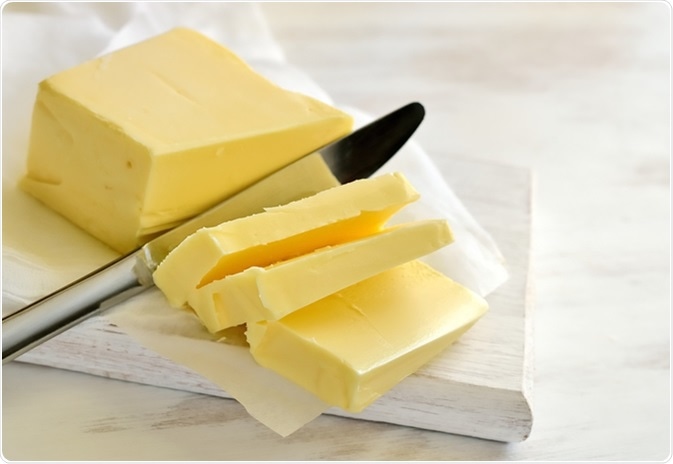Butter and margarine are used as spreads on bread and also for cooking and baking. There is a lot of controversy over the use of butter and margarine when it comes to their comparative health benefits.
In previous decades, the scientific view was that butter has a high fat content and is therefore bad for health. It was in this context that margarine was introduced as a healthier alternative. Later on, however, researchers, nutritionists, and health experts have come to realize that butter is healthier than margarine, as the latter is heavily processed from vegetable oil.
Butter and Margarine: A Comparison
Butter, which is a dairy product obtained after separating the cream from milk, is made up of 80%–82% milk fat, 16–17% water, with 1–2% of milk solids. It is available as salted butter, sweet, or reduced-fat butter. Butter also contains saturated fats, proteins, calcium, and phosphorus with some essential fat-soluble vitamins such as vitamins A, D, and E.

Butter. Image Credit: Fortyforks / Shutterstock
Margarine, on the other hand, is prepared from liquid vegetable oils by the process of hydrogenation process which saturates the fatty acids through the addition of hydrogen. Hydrogenation alters the molecular structure of fatty acids such that trans fats may be formed, and results in the fat assuming a semi-solid state. This increases the shelf life and durability of the margarine, and also makes foods cooked with this fat crisper. The more solid the consistency of the margarine, the greater the percentage of trans fat.

Margarine. Image Credit: JPC-PROD / Shutterstock
Both butter and margarine hold approximately the same percentage of fat, nearly 70%–80%. They differ from each other in regard to their preparation, ingredients, flavor, nutritional value, and type of fatty acids.
Margarine is the highly refined product synthesized from sunflower, canola, olive, and some other vegetable oils. It also contains food acid (lactic), salt, water, milk solids, preservatives, emulsifiers, synthetic vitamins A and D, and maltodextrin. These oils in their native state consist of unsaturated fats such as polyunsaturated and monounsaturated fats. Even after hydrogenation, they contain more unsaturated fats than does butter. The use of margarine therefore increases the level of low-density lipoprotein or ‘bad’ cholesterol, and reduces high-density lipoproteins (‘good’ cholesterol).
But not all margarines are healthy as the amount of trans fat varies among various types of margarines. For example, stick margarine has more trans fats than tub margarine does. Some margarines are available that have low trans fats and high unsaturated fats.
Although margarine can be cholesterol-free or may have low amounts of saturated fats, it also contains unhealthy trans fatty acids and toxic metal (such as cadmium and nickel) residues. Studies have proved that the presence of trans-fatty acids results in higher levels of low-grade inflammation in various tissues, which can have a severe impact on conditions such as arthritis and colitis.
On the other hand, butter is produced from animal milk, such as cow, sheep, goat, yak, and buffalo, by the simple mechanical process of churning. It contains high saturated fat and cholesterol but no trans fats. It enhances the absorption of other nutrients in food and tastes better than margarine.
Butter vs Margarine - Which Is Better?
Impact of Butter and Margarine Consumption
Since margarine has a variable but high trans fat level, the consumption of margarine may lead to an increased incidence of heart disease, cancer, and other diseases when compared with butter. Hence, butter is considered healthier than margarines. In women, according to the latest Harvard Medical Study, the intake of margarine increases the rate of incidence of heart disease by 53% over that associated with the consumption of the same volume of butter.
An experimental study was conducted on breast cancer in mice in relation to their consumption of butter and margarine, which has shown that the butter may provide a shielding effect against breast cancer. In the experiment, mice were fed with different diets containing a variety of oils such as butter, dextrin, safflower oil, and margarine. The results indicated that mice fed with safflower oil and margarine were highly prone to cancer, whereas the butter-fed mice showed a lower occurrence of cancer. Even when the mice were exposed to a carcinogen, the butter-fed rodents had fewer cases of cancer than the margarine-fed mice.
The lauric acid in butter is also important in eradicating or suppressing Candida and other fungal infections. Also, vitamin A which is a fat-soluble vitamin found abundantly in butter is vital for normal adrenal and thyroid functions. A study was also carried out comparing breast milk composition between Chinese and Canadian mothers who consumed either butter or margarine. It revealed that Canadian mothers who have a higher intake of trans fat-containing margarine than the Chinese have increased levels of trans fats in their milk, which points to a lower quality of breast milk in these mothers.
Healthy Diet
Even though butter is a better choice over margarine, people who are overweight or obese are often advised not to consume butter. For such people, margarine with low or no trans fat is sometimes considered to be the best option, since it may prevent increases in blood cholesterol level and heart disease.
This recommendation is highly controversial, however, because margarine contains many additives and is a purely synthetic product compared to all-natural, nutrient-dense butter. Many other researchers, therefore, urge that butter be used in moderation rather than margarine, pointing out that saturated fats are not deadly as was previously thought. Nowadays, trans fat-free margarines are produced by many manufacturers and are widely available in the market.
It is always wise to pick margarines with no trans fat, by checking the nutrition label of the product, if one really cannot eat butter.
References
- http://www.telegraph.co.uk/health-fitness/nutrition/butter-v-margarine-which-is-healthier/
- http://www.doctorshealthpress.com/food-and-nutrition-articles/butter-vs-margarine/
- http://www.mayoclinic.org/healthy-lifestyle/nutrition-and-healthy-eating/expert-answers/butter-vs-margarine/faq-20058152
- http://www.dailymail.co.uk/health/article-2274747/At-truth-Butter-GOOD--margarine-chemical-gunk.html
- https://www.healthyfamiliesbc.ca/home/blog/butter-vs-margarine-enough-already
- http://www.smh.com.au/lifestyle/diet-and-fitness/butter-versus-margarine-20150409-1mh6wb.html
- https://www.health.harvard.edu/nutrition/butter-vs-margarine
- http://www.eurofedlipid.org/meetings/archive/athens/5871/5871_0343.pdf
- http://americannutritionassociation.org/newsletter/margarine-or-butter
Further Reading
Last Updated: Feb 27, 2019